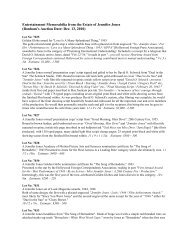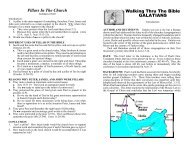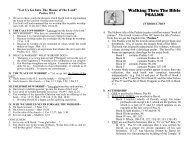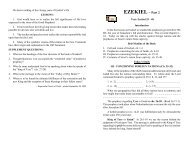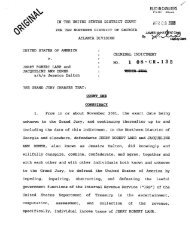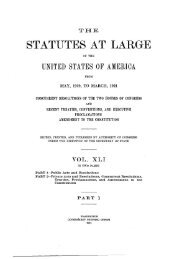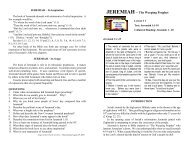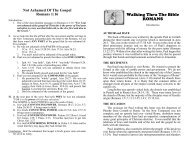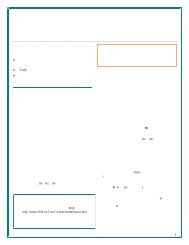Walking Thru The Bible 2 PETER JUDE - HiWAAY Information ...
Walking Thru The Bible 2 PETER JUDE - HiWAAY Information ...
Walking Thru The Bible 2 PETER JUDE - HiWAAY Information ...
You also want an ePaper? Increase the reach of your titles
YUMPU automatically turns print PDFs into web optimized ePapers that Google loves.
<strong>Walking</strong> <strong>Thru</strong> <strong>The</strong> <strong>Bible</strong><br />
2 <strong>PETER</strong><br />
2 <strong>PETER</strong><br />
<strong>JUDE</strong><br />
<strong>The</strong> Writer: <strong>The</strong> apostle Simon Peter is the author of this letter (1:1). <strong>The</strong><br />
internal evidence for his authorship include:<br />
1. <strong>The</strong> writer was present at the transfiguration of Christ (1:16-18)<br />
2. Jesus had told him something of his death (1:12-14; cf. John 21:18-<br />
19, John 13:36)<br />
3. He associated himself with the other apostles (3:2)<br />
4. He asserts that this is his second epistle (3:1)<br />
Probably no character other than Jesus himself is better known to New<br />
Testament readers than Peter. He, his brother Andrew, James, and John<br />
were partners in a fishing business; Jesus called them to be "fishers of men"<br />
(Luke 5:9-11). When the Lord chose twelve apostles, these four men were<br />
in that select group, and in all four lists of the apostles, Peter's name comes<br />
first (Matt. 10:2-4).<br />
Although his name means "a rock" he was sometimes more like<br />
shifting sand in his early career (Matt. 14:28-31; 16:21-23; 26:69-75).<br />
After the establishment of the church he was known as one of the "pillars"<br />
of the church at Jerusalem (Gal. 2:9).<br />
Time: Peter thought that his death was near when he wrote the letter (cf.<br />
1:12-14). If that is so we should date the epistle about AD 66-67. At this<br />
time there is great hostility between the Jews and the Romans and war is<br />
building between the Jews and the Gentiles in Palestine and Christians<br />
(especially Jewish Christians) are being persecuted mercilessly by Nero.<br />
Paul may have been put to death already in Rome about the time of<br />
Peter's writing and Peter is shortly to be put to death there also by Nero.<br />
This letter is about AD 67 just shortly before Peter's place and the likely<br />
place of its origin is Rome.<br />
<strong>The</strong> Readers: No specific church or location of churches are named in the<br />
letter and so it is generally regarded as a "catholic" or "universal" epistle.<br />
However, chapter 3:1 mentions that this is his second letter to them. If the<br />
reference is to I Peter then the recipients would be the churches of Asia-<br />
Minor and the date would be subsequent to Peter's other letter to them. <strong>The</strong><br />
first letter is address to Christians scattered among the Roman provinces of<br />
Pontus, Galatia, Cappadocia, Asia, and Bithynia (I Peter 1:1).
He mentions that Paul had also written to them. His reference to Paul<br />
is in glowing terms which assures us that any riff between Peter and Paul<br />
exists only in the minds of the critics. True, Paul had once rebuked Peter<br />
openly, but Peter is not one to hold resentment, especially when he has<br />
been wrong. In fact, he speaks of Paul's writing and puts it into the<br />
classification of "scripture."<br />
Style of Second Peter: While this is Peter's second epistle we notice that<br />
the style of 2 Peter is quite different than that of his first epistle. This is<br />
explained on the basis that the subject matter and the purpose of this second<br />
letter is vastly different than the first. <strong>The</strong> same man might write a love<br />
note to his wife one minute and then write a memo to his boss and we<br />
would expect the styles and contents of those to be quite different.<br />
In 2 Peter the emotional factor is different. In his first letter Peter<br />
wrote to comfort and strengthen a persecuted church while in this letter he<br />
is bent on warning those churches of false teachers which can be more<br />
disastrous than persecution.<br />
<strong>The</strong> similarities between 2 Peter and the book of Jude are very obvious.<br />
<strong>The</strong> two epistles apparently were not widely separated in time. <strong>The</strong>y are<br />
both writing about the same problem facing Christians at the same time and<br />
that would account for much similarly. But yet the books are still so<br />
parallel that it may well be that one of them is familiar with the other's<br />
writing and is making reference to it in his own letter. If that is the case,<br />
our question is, which one wrote first? It is very difficult to tell but there<br />
are certain points which tend to favor the priority of 2 Peter over Jude.<br />
Example: Peter's principal statement relative to the false teachers<br />
is in the future tense, 2:1-3, while Jude refers to them as having<br />
already come. Jude admonishes his readers to remember what the<br />
apostles had said concerning the coming "scoffers." <strong>The</strong> only time<br />
the identical word "scoffers" appear is in 2 Peter 3:3.<br />
<strong>The</strong> Unchanging Faith In A Changing World<br />
Jude 3<br />
Introduction:<br />
1. Out world is in a state of change. Aircraft and missiles are outmoded before<br />
they are off the assembly line. Textbooks and technologies are outdated by<br />
the time they are in print. It is “change” that sells automobiles, etc., year by<br />
year.<br />
2. <strong>The</strong> opinion is widespread that a modern age demands an updated religion.<br />
Science has made old beliefs taboo. Society rebels against traditional and<br />
obsolete modes of worship and service.<br />
I. <strong>The</strong> Realm Of <strong>The</strong> Changeable<br />
A. <strong>The</strong>re have been bast changes in Physical Expedients from the first to the 21<br />
centuries. Transportation; communication (Eph. 6:21,22); conveniences.<br />
B. Social customs have changed considerably in 20 centuries. Slavery (cf.<br />
Philemon and Onesimus, Eph. 6:5-9); dress has radically changed (Acts 21:11;<br />
1 Cor. 11); methods of greeting (Rom. 16:16).<br />
C. <strong>The</strong>re were temporary necessities in the early church that were to pass away<br />
because they would no longer be needed when the faith was established.<br />
Inspiration of apostles and prophets, Eph.4:11; miracles to confirm the spoken<br />
word (Mark 16:17, 20; Heb. 2:3,4); community of goods (Acts 2:44ff).<br />
II. <strong>The</strong> Realm of the Unchangeable<br />
A. <strong>The</strong> Godhead is the same today as ever. God changes not (Mal. 3:6); Christ<br />
remains the same (Heb. 13:8); the Holy Spirit abides forever (John 14:26).<br />
B. Satan and sin have remained unchanged. (1 John 2:16). <strong>The</strong> same works of<br />
the flesh are practiced (Gal. 5:19-21). <strong>The</strong> same type of people live.<br />
C. Man is basically the same today as always. He is still body-soul-and spirit. (1<br />
<strong>The</strong>ss. 5:23). He stills needs 4-fold growth (Luke 2:52). His choice are still<br />
two masters to serve, two roads to travel.<br />
D. Principles of faith and right have not and cannot change. (cf. Jude 3).<br />
1. Principles behind changing customs and temporary necessities of the 1st<br />
century are still obligatory. (Submission to husbands; modesty, brotherly<br />
affection; humility and hospitality, love).<br />
2. Principles of ethics and morals are unchanged. Matt 5-7 still relevant.<br />
3. Principles of faith are still binding. Heb. 11:6; Jn 8:24; Ja. 2:24<br />
III.<br />
Changing the Unchangeable<br />
A. <strong>The</strong>re are efforts to change the unchangeable. 1. New theology -- God is dead.<br />
(Ps. 14:1); 2. New Christology - Christ’s deity, miracles & resurrection denied<br />
(Mt. 22:42; 2 Pet. 2:1) . 3. New soteriology; 5. New morality.<br />
B. <strong>The</strong>re are efforts within the church to change the unchangeable. New<br />
hermeneutics; new rapport with error. <strong>The</strong>se are not new, but centuries old.<br />
Conclusion: 1. Change is permissible only in the area of expedients. (1 Cor.<br />
9:19f) 2. In matters of faith and doctrinal truth we much preach the unchanging<br />
gospel (Gal. 1:6-9) and stand for the old paths (Jer. 6:16).




